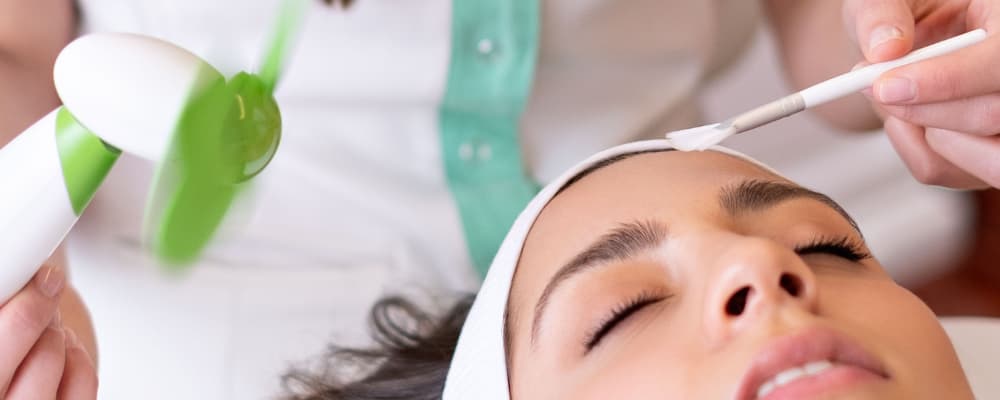
What are they for? Chemical peels are used to remove aged and damaged cells from the skin’s surface, stimulating regeneration and rejuvenation.
Types: There are several types of chemical peels, generally categorized as mild, medium, and deep.
Caution: Chemical peels are very safe when performed by specially trained medical personnel. It’s essential to carefully follow the post-peel instructions provided.
Recovery:
- Mild chemical peels require no downtime.
- Medium-depth peels may need a few days to a week for recovery.
- Deep chemical peels are serious procedures with a recovery period of at least a week, requiring enhanced skin care and protection.
What is a chemical peel?
A chemical peel involves applying a specific chemical solution to the skin to remove surface layers or stimulate regenerative processes within the skin. Sun exposure, acne, and aging often leave the skin uneven, wrinkled, and marked with spots or scars—issues that chemical peels address. They treat acne, wrinkles, hyperpigmentation, scars, enlarged pores, and stretch marks.
Types of chemical peels:
Mild Chemical Peels:
- Act on the skin’s surface layer (epidermis).
- Treat fine lines, acne, uneven skin tone, hyperpigmentation, and sun damage.
- Usually done in small series and repeated weekly or bi-weekly, though single treatments are also possible.
- Recovery time is typically a few hours, allowing you to resume daily activities immediately.
- Commonly used acids include alpha-hydroxy and beta-hydroxy acids.
Medium-Depth Chemical Peels:
- Act on the epidermis and upper dermis layers.
- Treat wrinkles, acne scars, enlarged pores, hyperpigmentation, and other skin imperfections.
- May need to be repeated for desired results.
- Recovery takes a few days to a week.
- Tri-chloroacetic acid (TCA) is often used.
Deep Chemical Peels:
- Penetrate the deeper skin layers.
- Treat deep wrinkles and scars, providing a lifting effect.
- Not repeated.
- Recovery takes several weeks, with special skin care required for months.
- Phenol or tri-chloroacetic acid is commonly used.
Combining with other treatments:
Chemical Peel + Dermapen (Microneedling): Simultaneous collagen production stimulation and imperfection removal. Dermapen micro-needles enhance the peel’s effectiveness in treating scars or wrinkles.
Chemical Peel + Mesotherapy: Intensively improves skin quality with deep hydration, regeneration, and even skin tone in one treatment.
Chemical Peel + Oxygen Treatment: Accelerates skin regeneration with oxygen and nourishing serums.
Pre-treatment considerations:
Consultations provide all necessary information. Some general rules include:
- Your skin characteristics determine if you’re a good candidate.
- Certain types should be avoided if pregnant or breastfeeding.
- Post-peel, your skin will be sensitive to sunlight, necessitating sunscreen use.
- Recovery time varies by procedure.
Preparation for a chemical peel:
Consultations:
- Medical history: Answer questions about past and present health conditions, medications, and cosmetic procedures.
- Examination: A skin exam to choose the appropriate peel type.
- Expectations: Discuss desired outcomes and potential risks to understand the number of treatments needed and expected results.
- Instructions: Pre-peel skin preparation, post-peel recovery, and skin protection guidelines.
During the procedure:
A controlled application of the chosen chemical solution to the prepared skin is done. Mild to intense tingling is often felt, alleviated with cooling. Depending on the peel type, the process ends with solution removal or neutralization, followed by soothing cream application.
Mild peels usually take about 30 minutes, while medium to deep peels can take up to 60 minutes.
Post-treatment:
Mild peels might cause slight redness, typically resolving in a few hours. Medium-depth peels may cause slight peeling, while deeper peels result in more intense peeling.
For the best results, follow these tips:
- Avoid tanning beds and sun exposure during skin recovery.
- If peeling hands, avoid UV lamps during manicures.
- Apply high SPF sunscreen daily, reapplying every two hours.
- Use daily moisturizing cream.
Risks and complications:
- Scarring and hyperpigmentation: New scars and color changes can result from improper aftercare, like picking peeling skin or sun exposure without SPF.
- Infections: Rare but possible after intensive peels.
- Phenol peels: Can have serious complications, hence strictly performed by a physician.
Results:
YOU WILL GET: Improved skin texture, even skin tone, radiant and smooth complexion.
YOU WILL LOSE: Hyperpigmentation, fine lines, freckles, spots, melasma.
YOU WILL IMPROVE: Acne-prone skin, old and new scars, with deep peels offering improvements comparable to surgical procedures.
